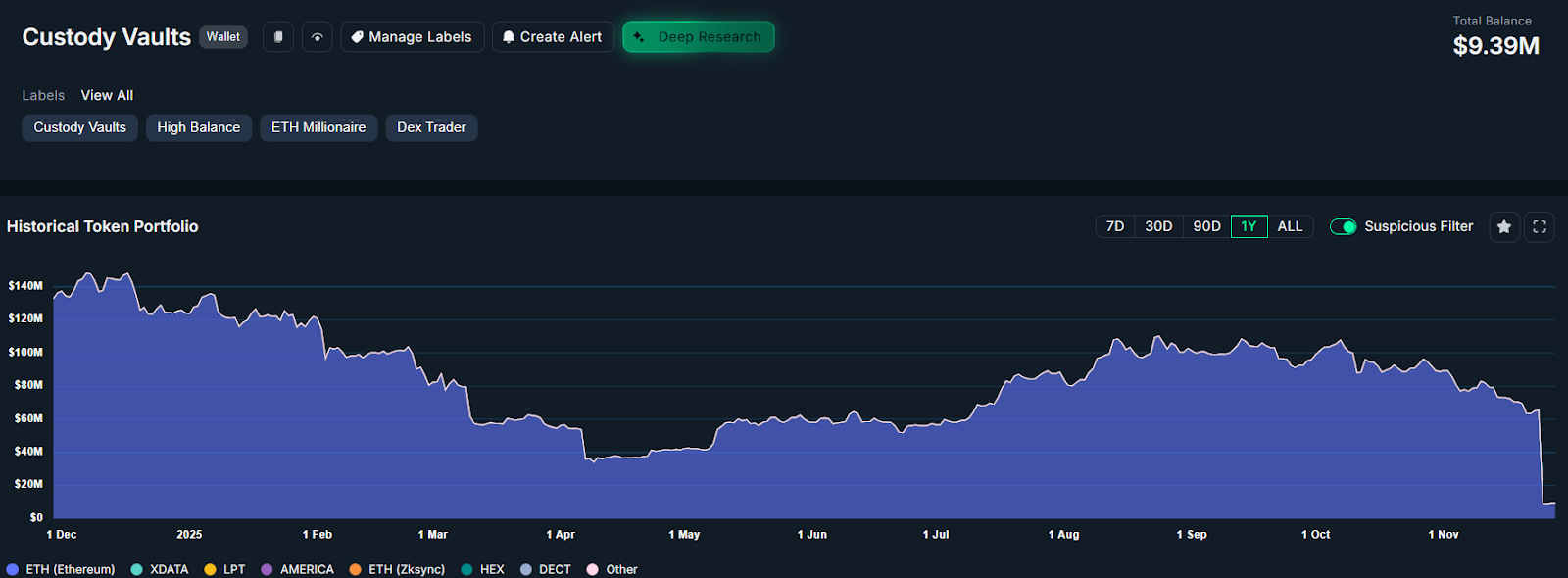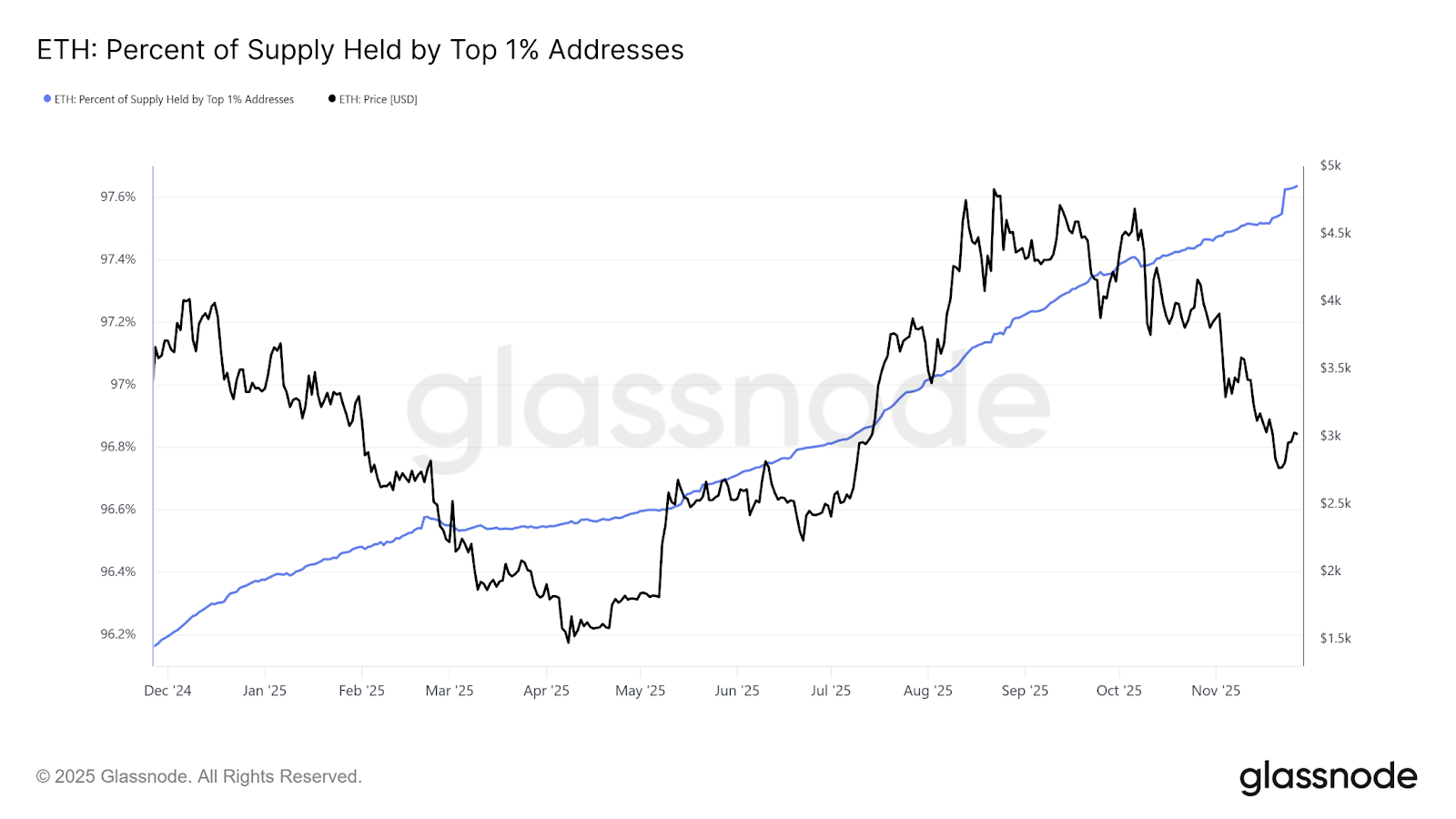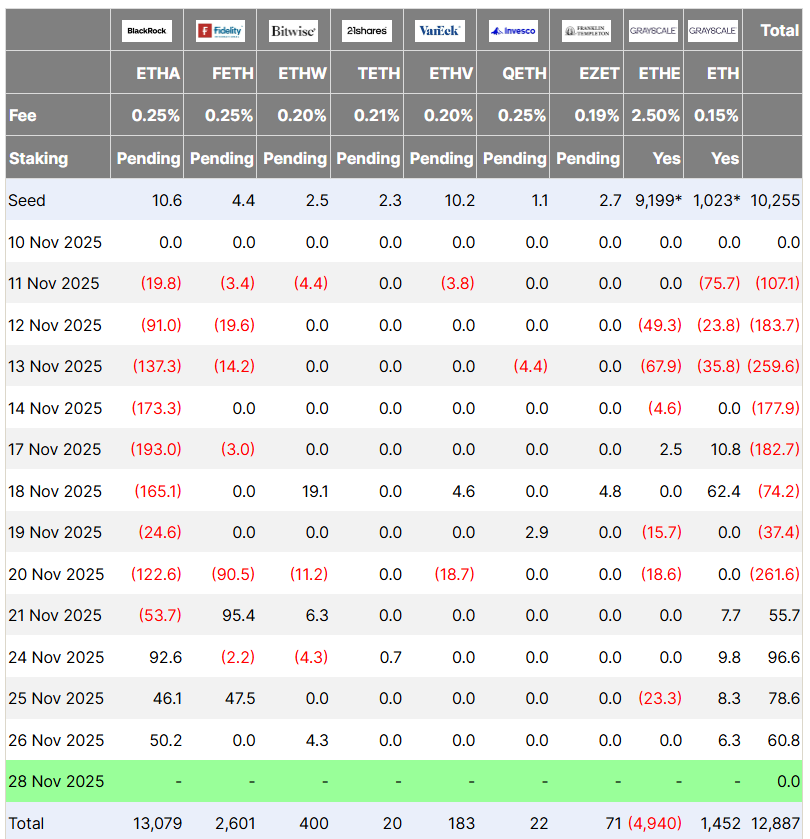Ether whale accumulation continues unabated among the top 1% of holders, reaching 97.6% of supply despite market pressures and selective OG sales. This steady buying signals confidence in Ethereum’s long-term value, even as some early investors realize gains after over a decade.
-
Top 1% Ether holders now control 97.6% of supply, up from 96.1% a year ago, per Glassnode data.
-
Ether ETFs saw $60 million in net inflows on Wednesday, reversing recent outflows and boosting sentiment.
-
An early ICO participant sold $60 million in ETH, leaving $9.3 million after a 9,500-fold return, according to Nansen.
Ether whale accumulation persists amid downturns, with top holders amassing more ETH. Discover how ETF inflows and OG sales shape Ethereum’s future—stay informed on crypto trends today.
What Is Driving Ether Whale Accumulation Despite the Market Downturn?
Ether whale accumulation refers to large-scale buying by the biggest Ethereum holders, who continue to increase their stakes even as broader market conditions soften. The top 1% of Ether addresses now hold 97.6% of the total supply, a notable rise from 96.1% a year prior, as reported by blockchain analytics platform Glassnode. This trend underscores sustained confidence in Ethereum’s ecosystem, including upcoming upgrades like Fusaka, despite short-term volatility.
While some original Ethereum ICO participants are cashing out after impressive long-term gains, the dominant narrative among whales remains one of accumulation. For instance, an early investor who bought 254,000 Ether tokens for $79,000 at $0.31 each during the 2014 ICO has seen those holdings balloon to over $757 million today. This week’s sale of $60 million in Ether reduced their wallet balance to $9.3 million, per data from crypto intelligence platform Nansen.

Ethereum ICO participant wallet “0x2Eb,” token holdings, 1-year chart.Source: Nansen
The sale, from wallet 0x2Eb, represents a calculated profit-taking move rather than panic, as the address has been gradually offloading since early September. Market observers note mixed reactions: some hail the holder’s decade-long patience, while others view OG sales as potential bearish signals. Yet, this activity pales against the broader whale buildup, suggesting selective divestment rather than widespread fear.
How Are Ether ETF Inflows Influencing Whale Behavior?
U.S. spot Ether exchange-traded funds have shifted to positive territory, recording $60 million in net inflows on Wednesday after eight days of outflows, according to investment tracking firm Farside Investors. This marks the fourth straight day of gains, reflecting improving buyer sentiment amid stabilizing prices. The inflows align with whale accumulation, as institutional interest via ETFs provides a regulated entry point for large investors wary of direct crypto exposure.
Analyst Iliya Kalchev from digital asset platform Nexo describes the market response as “measured,” noting that steady ETF inflows combined with rising derivatives activity indicate selective rebuilding of positions. “Investors are not rotating aggressively but are instead focusing on core exposures like Ether,” Kalchev stated in comments to financial media. This cautious optimism ties into Ethereum’s technical roadmap, where the forthcoming Fusaka upgrade promises enhanced scalability and efficiency, further bolstering whale confidence.

ETH: Percent of Supply Held by Top 1% Addresses, 1-year chart. Source: Glassnode
Glassnode’s metrics highlight the concentration: the top 1% holders’ share has climbed steadily, insulating Ethereum’s supply from retail sell-offs. Despite a recent market dip, this group—often institutional whales—views dips as buying opportunities, supported by on-chain data showing reduced exchange inflows and increased staking activity. Experts from platforms like Nexo emphasize that such accumulation patterns have historically preceded rallies, though current levels remain within normalized ranges without overextension.

Ethereum ETF Flow in USD, million. Source: Farside Investors
The ETF resurgence is particularly telling, as it democratizes access for traditional investors, indirectly fueling whale strategies. With over $60 million added in a single day, these vehicles now hold significant Ether portions, mirroring the top holders’ playbook. Nansen’s wallet tracking reveals no mass exodus; instead, dormant addresses are activating for strategic moves, aligning with ETF momentum.
Frequently Asked Questions
What Impact Do OG Ethereum Investor Sales Have on Whale Accumulation?
OG sales, like the recent $60 million Ether dump by an ICO participant, represent profit-taking after massive returns but do not derail overall whale accumulation. The top 1% holders have increased their supply share to 97.6%, per Glassnode, showing resilience. These isolated events signal maturity in the market rather than systemic weakness, with whales focusing on long-term Ethereum growth.
Why Are Ether ETFs Seeing Inflows Now Amid Market Volatility?
Ether ETFs are attracting inflows because they offer a secure way for investors to gain exposure during volatility, with $60 million added Wednesday per Farside Investors. This follows corrections and builds on Ethereum’s upgrade pipeline, like Fusaka. It’s a sign of growing institutional trust, making it easier for everyday users to participate in Ether’s potential upside.
Key Takeaways
- Steady Whale Growth: Top 1% Ether holders now control 97.6% of supply, up year-over-year, demonstrating unwavering confidence per Glassnode analytics.
- ETF Momentum Shift: Recent $60 million inflows reverse outflows, highlighting renewed institutional interest in Ethereum amid stabilizing conditions.
- Balanced Market Signals: OG profit-taking contrasts with accumulation trends—monitor on-chain data for entry points into Ethereum’s ecosystem.
Conclusion
In summary, Ether whale accumulation by the top 1% holders persists strongly at 97.6% supply control, even as select OG investors like the 0x2Eb wallet realize gains from early ICO positions. Ether ETF inflows, totaling $60 million recently, further reinforce this bullish undercurrent despite market dips. As Ethereum advances with upgrades like Fusaka, these trends point to a robust future—investors should track on-chain metrics closely for informed decisions in the evolving crypto landscape.
